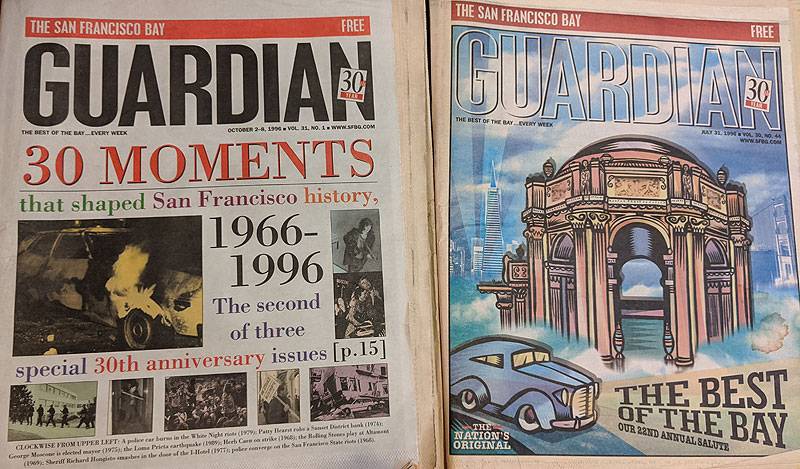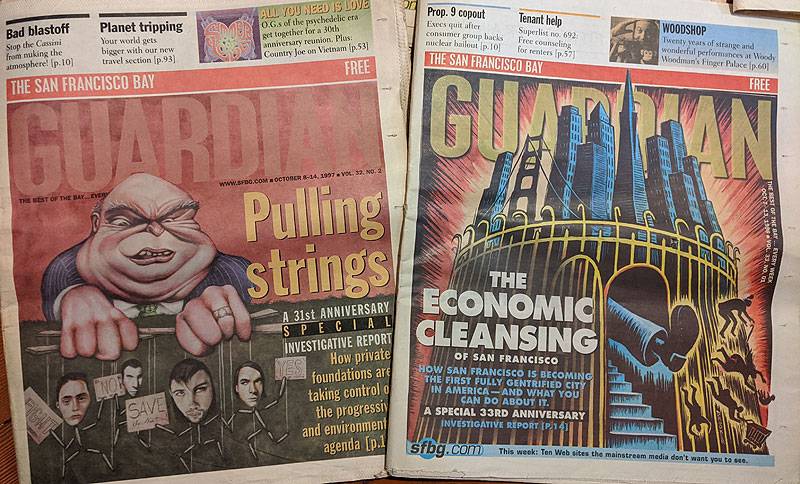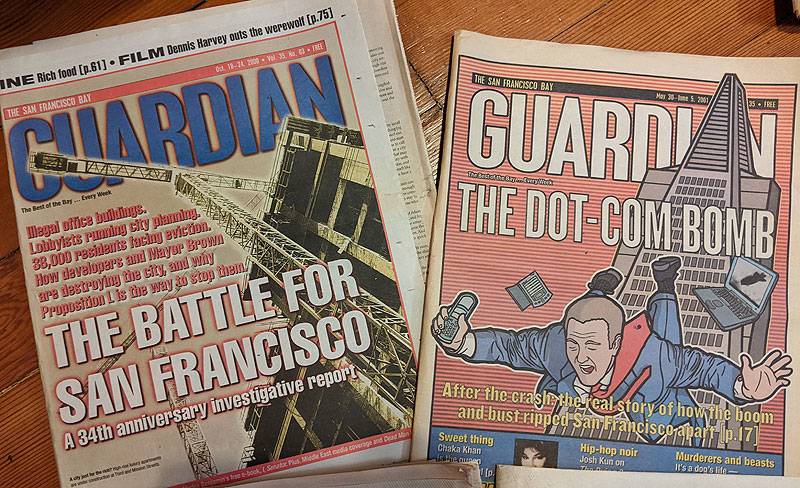Small Is Not Beautiful: Life at the Bay Guardian
Historical Essay
by Tom Wetzel, 1987
San Francisco Bay Guardian covers from 1996, during their 30th anniversary, almost a decade after this article was written.
Its 9:00 Friday night. The last stragglers from the editorial department have departed. The other typesetter and I have the Bay Guardian building to ourselves. Two piles of manila folders sit on the typesetting machine, to my left. They contain the order slips for classified ads. One pile gradually dwindles as the folders are moved to the other pile, marking my progress. The machine occasionally clanks as it changes type style or size.
Love is friendship caught fire!" appears at the top of the video screen. Ah, yes. Tire relationships section. This, the fattest of the file folders, should keep my fingers busy for the rest of my 9-l0-hour-long shift. When I first began typesetting the classifieds, I found the relationships section sort of poignant. "All those people out there looking to connect with somebody." I thought about the care some people take in choosing just the right words. But as the Friday nights came and went, I soon became jaded and the words slipped through my fingers in a blur.
The San Francisco Bay Guardian was founded by Bruce Brugmann and his wife, Jean Dibble, in 1966. Unlike other alternative papers of that era, such as the Berkeley Barb and the L.A. Free Press, the BG wasn't countercultural. Nor did it follow the political currents of the '60s New Left, as did the National Guardian in New York. Brugmann's journalistic background was in the commercial dailies.
Nonetheless, the Bay Guardian has always had political pretensions, and its pages uphold various leftist causes—environmental protection, abortion rights, rent control, unions, anti-Manhattanization—and expose monopolistic abuses. To the BG "politics" is primarily a matter of elections, and, thus, of the politicians who control the top-down machinery of American government. The paper has been supportive of such groups as Democratic Socialists of America, Berkeley Citizens Action, and Tom Hayden's now-defunct Campaign for Economic Democracy.
In 1997 and 1998, the paper continued to run exposés from a left-wing point of view, even if the paper's own operations were decidedly anchored to a logic of small business and a nonunion workforce.
In 1971 the Bay Guardian was "a chronically struggling business," writes James Brice, "with a spare 17,000 subscribers paying for the four issues it managed to publish" that year. Dibble and Brugmann hoped the paper could make money, says Brice, "if it went weekly" but they lacked the necessary capital. Ironically, they got it from their arch-rivals, the big dailies.
Like a number of other papers in the Bay Area, the BG had filed an antitrust suit in the late 60's against the two remaining dailies in San Francisco, the Hearst-owned Examiner and the Chronicle. The two dailies had merged their advertising and production operations, an action authorized by the Newspaper Preservation Act of 1965, which granted a special antitrust exemption to daily newspapers.
In May 1975, Brugmann and Dibble dropped their lawsuit in exchange for an out of court settlement of $500,000. (The lawyers got about $200,000.) This was a rather shrewd move as the papers that pursued the lawsuit to the end (such as the Pacific Sun) eventually lost.
When the BG became a free weekly in the late '70s, the larger circulation and weekly schedule enabled the paper to capture a growing share of the Bay Area advertising market. Although advertising by the major local retailers (Macy's, Emporium Capwell, etc.) remains safely in the pocket of the big dailies, the BG’s increased circulation made it attractive to national advertisers, and the full-page ads for cigarettes and liquor contributed considerably to BG revenue. The paper made its first profit in fiscal 1982. From January 1982 to January 1985 the paper's classified ad lineage increased from 20 cents to 60 cents, this means the paper's classified ad revenue increased by approximately 495%. And in 1981 management increased the print-run of its entertainment section to 100,000 copies, and then jacked up the rates for entertainment advertising.
The BG’s craven reliance on business advertising necessarily shapes its editorial direction. The packet distributed to potential advertisers candidly admits this: 'The Guardian tailors its editorial material to (an] audience" of 24-to-36-year-old "self-involved consumers. "EXPOSE YOURSELF! to 180,000 hot young professionals with money to burn." Certain issues each year were planned out in advance so as to appeal to specific segments of the business community (consumer electronics, wine, etc.)
Despite the BG’s new-found profitability and ever-growing production pressures, wages remained low. In 1982 production artists and proofreaders were paid about $5.50 per hour. By 1985 the rate had inched up from $6.00 to $6.50. Typesetters were paid $5.50 when I was hired in 1982; today the starting rate is $7.50. Pay for clerical and sales staff in Classified was approximately the same. It was considered a Privilege to work in Editorial but pay in that department was, if anything, even lower. Editorial staff is paid a salary, which enables the BG to avoid overtime pay. At the end of 1981, the copy editor was making the equivalent of $6.50 an hour, while some editorial staffers were paid even less. Early in 1985, the woman hired to compile the weekly entertainment listings had been assured a four-day week for $150. But she found that the job required a 40-hour week, and she decided to have a chat with Alan Kay, the managing editor. "Am I going to get paid for Fridays?" she asked. Alan put his head in his hands, then looked up at her. "How about a restaurant meal?" he asked plaintively. Her pay amounted to less than $4 per hour.
ENTER DISTRICT 65
I was hired in 1982 towards the end of a year-long effort to organize the staff into District 65. District 65, a union of textile and dry goods wholesale workers originally founded by Communists in the '30s, has organized publishing industry workers in New York City in recent years. Here in San Francisco, District 65, now affiliated to the United Auto Workers (UAW), is the union of the Mother Jones staff.
Low pay and lack of any say in decisions seemed to be the two main areas of concern among BG workers. When management learned that members of the staff were trying to persuade co-workers to join a union, a meeting was called. Brugmann ranted about how unions would MEAN "outside control" of the paper.
On the issue of low pay, management pleaded poverty. Members of the staff responded by asking what salaries management were getting. If the paper's finances are limited, a number of staffers thought, then management salaries should be reduced to allow raises for the lowest paid. But BG management refused to tell us how much money managers were taking out of the paper.
About this time a meeting with a representative of District 65 was held for BG workers. The issues of the paper s editorial direction and its increasing subservience to advertisers were raised, along with the idea of lowering management salaries so as to raise workers' pay. "Unions can't take on issues of editorial content, or ask that managers' salaries be lowered," Dibble asserted.
What she was getting at is that the National Labor Relations Board (NLRB) and courts cannot require employers to negotiate these issues. But just because the government won't compel an employer to negotiate contested issues doesn't mean unions can't raise them. A workers organization can try to fight for anything it wants to. What workers can achieve ultimately depends upon the power they can bring to bear on the situation. This is affected by such factors as internal cohesion among the workers and support in the community. This is true even for issues that employers are nominally required by law to negotiate, such as wages, hours and benefits. The government can't be counted on to support workers' demands.
Some members of the BG staff were dissatisfied with District 65's rather narrow, legalistic approach. What was needed was an independent organization, some of us thought, an organization that we could control directly. An independent group did continue for a while, but eventually stopped meeting. Nonetheless, a pattern of solidarity and mutual consultation had been established and continued informally.
THE STRIKE IN 1976
As the District 65 organizing drive fizzled out, about a dozen people quit. This was not the first BG unionization attempt. The first such effort led to an NLRB vote in December 1975, which certified the Bay Area Typographical Union (ITU) and the Newspaper Guild as the recognized unions at the paper.
Staff pay had been very low in the early '70s—base rates then ranged from $2.50 to $3.75 per hour. Benefits were nonexistent. A long-standing graffito in the employees' lavatory had the words "Guardian health plan" inked in large letters, with an arrow pointing to a drawing of a book. The book was entitled "Holy Bible."
In its early days the paper had an informal atmosphere and lines of authority were rather vague—not unusual at small "start-up" companies. Then came the $300,000 from the anti-trust settlement. "The deathly poor newspaper that had shared its poverty with its beggarly staff now seemed richly endowed," writes James Brice. ("A look back at the strike nobody won" Mediafile, June, 1973)
But decisions about what to do with the money were quickly made by those at the top, before staffers had a chance to have any say over what should be done with it. Money was poured into new typesetting equipment and a down-payment on a building. "The settlement made us feel more left out of the decision-making process," recalled Katy Butler (now a Chronicle reporter). At the same time, the change to a weekly schedule meant increased production pressures.
Though staffers were concerned about the low wages and lack of benefits or job security, these issues were "secondary to job satisfaction and worker participation in decision-making," according to Brice. "A union seemed to be a sure way to gain leverage." Hence the vote for the ITU and Newspaper Guild.
After six months of table-pounding negotiations, the Union reduced its demand to 25 cents per hour across-the-board. Employees also wanted one week notice of termination, an agreed grievance procedure, limited sick pay, and pay for overtime. But the BG refused these demands, and in June of '76, 21 employees, both full-time and part time walked out.
The bitter strike—marked by vandalism and sabotage—dragged on for eight months.
Recently, Bruce Brugmann has described this struggle as an attempt by "the unions from the local newspaper monopoly...to impose their standard contract on a struggling, competitive, independent small business "* (Bill Mandel's column, SF Examiner, Oct. 29, 1986). The concerns of the workers thus disappear, they become non-entities. Funny how he was no less opposed, in 1982 to District 65, which has no contracts at the "monopoly" dailies.
INFORMAL SOLIDARITY
Informal solidarity, as I mentioned, had continued to exist in the wake of the District 65 organizing drive even though no ongoing organization had gotten entrenched at the BG. This was necessary to deal with the BG’s arbitrary management practices. An incident in 1984 illustrates this.
The BG advertises its job openings in the classified section of the paper each week. The BG Employee Manual states that notice of openings must be posted and current employees given preference. However, while typesetting the BG job ads one week, the typesetters came across an advertisement for an ad designer.
But the BG already had an ad designer, a Japanese immigrant who had done the job for a number of years. Management had tried to demote him a couple of years before, but then backed down". Anyway, a group of artists and typesetters protested the running of this ad, but our boss disclaimed responsibility for this violation of written policy and past guarantees. Some time that weekend the job ad disappeared from the classified page flats and the ad was erased from computer disk.
BG management were not very happy about this sabotage, we heard, and rumors of firings were in the air. "If they fire anyone, we should all go on strike," one woman remarked to me. I think quite a few production staff members felt that way. However, a meeting was held and we were reassured that no demotion was going to take place. At the same time, four people were singled out for written warnings about "tampering with the work product.
In the wake of this incident some of us met with a business agent from the Graphic Communications Union (GCIU). The press operators at the shop where the BG was printed belong to this union. If we ever went on strike, we knew that the first thing we'd want to do would be to appeal to the press operators to refuse to print the paper.
The business agent gave us a copy of the printing industry master contract, which some of us discussed later. The worst clause in the contract stated: "There will be no strike or other economic pressure through concerted action by the employees and/or the union." In other words, workers' hands ate tied while any beefs inch through the bureaucratic grievance machinery to final arbitration. "But the only way we are able to get anything around here is through collective pressure," one BG staffer commented.
The contract also stipulated that dues be deducted from the employees' paychecks and then sent directly to the union. In decades past, dues were not deducted and shop stewards had to go around hustling the members' dues, which gave members the opportunity to push their concerns directly.
Why couldn't BG employees remain independent and still appeal to the press operators to not print the paper in the event of a strike? Another clause in the press operators' contract explains the problem: "Employees...shall not be required to cross a picket line because of a strike if sanctioned by the Central Labor Council..." This means the printers are not allowed to take action to support a strike—such as refusing to print a struck paper—without the approval of the top local AFL-CIO officials. Without such sanction, the printers would be at risk of losing their jobs. The purpose of this sort of contract is to ensure that workers solidarity is controlled by top officials rather than the workers themselves. The employers gain by the union's promise not to disrupt production and the officials gain control over the labor movement.
Even if the bureaucratic AFL-CIO-type unions encourage little real solidarity between workers in different workplaces, small groups of workers will tend to seek the protection of these unions because they offer at least the promise of greater leverage, however illusory this may be. This tendency is likely to prevail until there emerges an independent workers movement that can provide an alternative for groups of workers seeking a larger movement to ally with.
OBSTACLES TO WORKER ORGANIZATION
The BG has been able to maintain a "union-free environment" and contain periodic bouts of disaffection through a combination of circumstances. For one thing, many BG staffers are employed part-time. I've overheard the production manager say to a prospective new hire, "This job is just to get some extra money." When people have another job, they are less likely to regard the part-time job as important enough to commit time to organizing with others. A workforce becomes fragmented as part-timers predominate. When people don't see each other regularly, if at all; they develop less of the cohesion that is natural to a group of people who work together, and which is necessary for collective action.
The large number of part-timers lowers BG labor costs. Less than half of the production staff worked the minimum 30 hours a week needed to qualify for heath insurance. Low wages, minimal benefits and lousy conditions tend to produce turnover. While I worked at the BG, the average production employee stayed only eight months.
During the first dotcom boom in 2000, and then in the 2001 bust, the SFBG decried the disaster that the new business model was imposing on San Francisco—even though its own reliance on precarious and contract labor prefigured much of the practices adopted by the tech industry in the 21st century.
Organization among workers in small, low-wage business like the BG is more likely to develop when there is a broader movement with which groups of workers in particular workplaces can ally themselves. A non bureaucratic workers movement, that is actually nut by rank-and-file workers themselves, would not be as dependent on institutionalized contract bargaining to have a presence in workplaces. This would make it easier for workers to participate in the movement despite high turnover and movement from job to job.
The Industrial Workers of the World (IWW) was an example of such a movement in the earlier decades of this century. Many of the people who worked in mines, aboard ships, on construction projects, and on farm harvests in the Western states in those years moved around from job to job. Nevertheless, the IWW was able to maintain effective organizations in number of these industries despite the absence of a stable workforce. The movement's presence in a workplace didn't depend upon a union contract or government certification but on workers acting "in union" with each other. Workers remained members of the union no matter where they worked. And workers in one workplace were less isolated as they had a sense of being part of a larger movement. The mix of occupations and industries may be different today, but the failures of the top-down, institutionalized unions show clearly the need for a new, non-bureaucratic workers movement.



